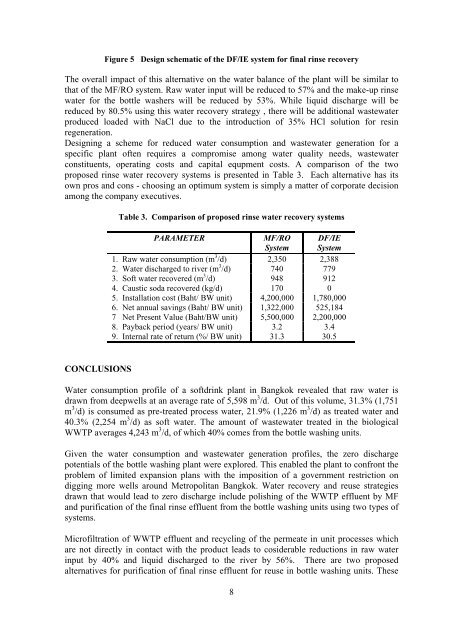1 Exploring Zero Discharge Potentials for the Sustainability of a ...
1 Exploring Zero Discharge Potentials for the Sustainability of a ...
1 Exploring Zero Discharge Potentials for the Sustainability of a ...
You also want an ePaper? Increase the reach of your titles
YUMPU automatically turns print PDFs into web optimized ePapers that Google loves.
Figure 5 Design schematic <strong>of</strong> <strong>the</strong> DF/IE system <strong>for</strong> final rinse recovery<br />
The overall impact <strong>of</strong> this alternative on <strong>the</strong> water balance <strong>of</strong> <strong>the</strong> plant will be similar to<br />
that <strong>of</strong> <strong>the</strong> MF/RO system. Raw water input will be reduced to 57% and <strong>the</strong> make-up rinse<br />
water <strong>for</strong> <strong>the</strong> bottle washers will be reduced by 53%. While liquid discharge will be<br />
reduced by 80.5% using this water recovery strategy , <strong>the</strong>re will be additional wastewater<br />
produced loaded with NaCl due to <strong>the</strong> introduction <strong>of</strong> 35% HCl solution <strong>for</strong> resin<br />
regeneration.<br />
Designing a scheme <strong>for</strong> reduced water consumption and wastewater generation <strong>for</strong> a<br />
specific plant <strong>of</strong>ten requires a compromise among water quality needs, wastewater<br />
constituents, operating costs and capital equpment costs. A comparison <strong>of</strong> <strong>the</strong> two<br />
proposed rinse water recovery systems is presented in Table 3. Each alternative has its<br />
own pros and cons - choosing an optimum system is simply a matter <strong>of</strong> corporate decision<br />
among <strong>the</strong> company executives.<br />
CONCLUSIONS<br />
Table 3. Comparison <strong>of</strong> proposed rinse water recovery systems<br />
PARAMETER MF/RO DF/IE<br />
System System<br />
1. Raw water consumption (m 3 /d) 2,350 2,388<br />
2. Water discharged to river (m 3 /d) 740 779<br />
3. S<strong>of</strong>t water recovered (m 3 /d) 948 912<br />
4. Caustic soda recovered (kg/d) 170 0<br />
5. Installation cost (Baht/ BW unit) 4,200,000 1,780,000<br />
6. Net annual savings (Baht/ BW unit) 1,322,000 525,184<br />
7 Net Present Value (Baht/BW unit) 5,500,000 2,200,000<br />
8. Payback period (years/ BW unit) 3.2 3.4<br />
9. Internal rate <strong>of</strong> return (%/ BW unit) 31.3 30.5<br />
Water consumption pr<strong>of</strong>ile <strong>of</strong> a s<strong>of</strong>tdrink plant in Bangkok revealed that raw water is<br />
drawn from deepwells at an average rate <strong>of</strong> 5,598 m 3 /d. Out <strong>of</strong> this volume, 31.3% (1,751<br />
m 3 /d) is consumed as pre-treated process water, 21.9% (1,226 m 3 /d) as treated water and<br />
40.3% (2,254 m 3 /d) as s<strong>of</strong>t water. The amount <strong>of</strong> wastewater treated in <strong>the</strong> biological<br />
WWTP averages 4,243 m 3 /d, <strong>of</strong> which 40% comes from <strong>the</strong> bottle washing units.<br />
Given <strong>the</strong> water consumption and wastewater generation pr<strong>of</strong>iles, <strong>the</strong> zero discharge<br />
potentials <strong>of</strong> <strong>the</strong> bottle washing plant were explored. This enabled <strong>the</strong> plant to confront <strong>the</strong><br />
problem <strong>of</strong> limited expansion plans with <strong>the</strong> imposition <strong>of</strong> a government restriction on<br />
digging more wells around Metropolitan Bangkok. Water recovery and reuse strategies<br />
drawn that would lead to zero discharge include polishing <strong>of</strong> <strong>the</strong> WWTP effluent by MF<br />
and purification <strong>of</strong> <strong>the</strong> final rinse effluent from <strong>the</strong> bottle washing units using two types <strong>of</strong><br />
systems.<br />
Micr<strong>of</strong>iltration <strong>of</strong> WWTP effluent and recycling <strong>of</strong> <strong>the</strong> permeate in unit processes which<br />
are not directly in contact with <strong>the</strong> product leads to cosiderable reductions in raw water<br />
input by 40% and liquid discharged to <strong>the</strong> river by 56%. There are two proposed<br />
alternatives <strong>for</strong> purification <strong>of</strong> final rinse effluent <strong>for</strong> reuse in bottle washing units. These<br />
8
















